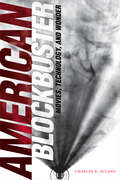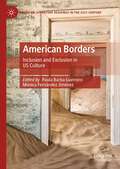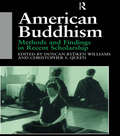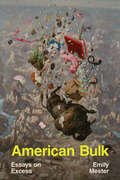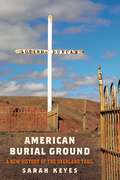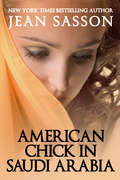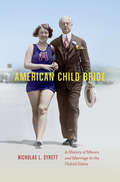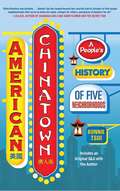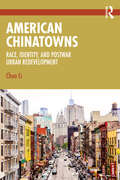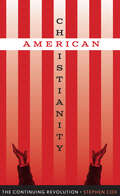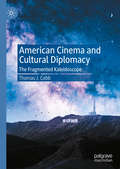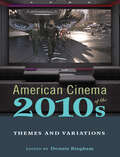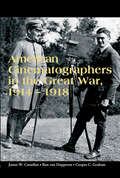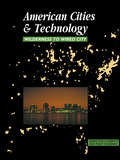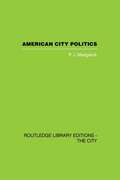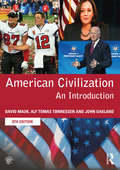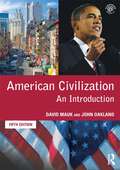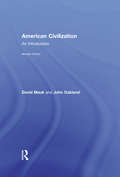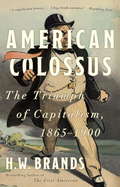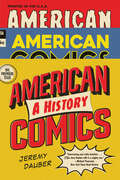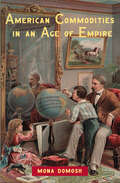- Table View
- List View
American Blockbuster: Movies, Technology, and Wonder (Sign, Storage, Transmission)
by Charles R. AclandBen-Hur (1959), Jaws (1975), Avatar (2009), Wonder Woman (2017): the blockbuster movie has held a dominant position in American popular culture for decades. In American Blockbuster Charles R. Acland charts the origins, impact, and dynamics of this most visible, entertaining, and disparaged cultural form. Acland narrates how blockbusters emerged from Hollywood's turn to a hit-driven focus during the industry's business crisis in the 1950s. Movies became bigger, louder, and more spectacular. They also became prototypes for ideas and commodities associated with the future of technology and culture, accelerating the prominence of technological innovation in modern American life. Acland shows that blockbusters continue to be more than just movies; they are industrial strategies and complex cultural machines designed to normalize the ideologies of our technological age.
American Borders: Inclusion and Exclusion in US Culture (American Literature Readings in the 21st Century)
by Paula Barba Guerrero Mónica Fernández JiménezAmerican Borders: Inclusion and Exclusion in US Culture provides an overview of American culture produced in a range of contexts, from the founding of the nation to the age of globalization and neoliberalism, in order to understand the diverse literary landscapes of the United States from a twenty-first century perspective. The authors confront American exceptionalism, discourses on freedom and democracy, and US foundational narratives by reassessing the literary canon and exploring ethnic literature, culture, and film with a focus on identity and exclusion. Their contributions envision different manifestations of conviviality and estrangement and deconstruct neoliberal slogans, analyzing hospitable inclusion in relation to national history and ideologies. By looking at representations of foreignness and conditional belonging in literature and film from different ethnic traditions, the volume fleshes out a new border dialectic that conveys the heterogeneity of American boundaries beyond the opposition inside/outside.
American Buddhism: Methods and Findings in Recent Scholarship (Routledge Critical Studies in Buddhism)
by Duncan Ryuken Williams Christopher QueenThis is the first scholarly treatment of the emergence of American Buddhist Studies as a significant research field. Until now, few investigators have turned their attention to the interpretive challenge posed by the presence of all the traditional lineages of Asian Buddhism in a consciously multicultural society. Nor have scholars considered the place of their own contributions as writers, teachers, and practising Buddhists in this unfolding saga. In thirteen chapters and a critical introduction to the field, the book treats issues such as Asian American Buddhist identity, the new Buddhism, Buddhism and American culture, and the scholar's place in American Buddhist Studies. The volume offers complete lists of dissertations and theses on American Buddhism and North American dissertations and theses on topics related to Buddhism since 1892.
American Bulk: Essays on Excess
by Emily MesterRaised with hoarding and compulsive shopping, Emily Mester is caught in between. What happens when consumption begins to consume you back? In a series of deeply personal essays, Mester explores how the things we buy, eat, amass, and discard become an intimate part of our lives. We guiltily watch Amazon boxes pile up on the porch, wade through endless reviews to find the perfect product, and crave the comforting indulgence of a chain restaurant. With humor and sharp intellect, Mester reflects on the joys and anxieties of Costco trips, how a seasonal stint at Ulta Beauty taught her the insidious art of the sale, and what it means to get “mall sad.” In a nuanced examination of diet culture and fatness, Mester recounts her teenage summer at fat camp and the unexpected liberation she finds there. Finally, she ventures to Storm Lake, Iowa, to reckon with her grandmother’s abandoned hoard, excavating the dysfunction that lies at the heart of her family’s obsession with stuff. American Bulk introduces readers to a striking new literary talent from the American heartland, one who dares to ask us to regard consumption not with guilt but with grace and empathy.
American Burial Ground: A New History of the Overland Trail (America in the Nineteenth Century)
by Sarah KeyesIn popular mythology, the Overland Trail is typically a triumphant tale, with plucky easterners crossing the Plains in caravans of covered wagons. But not everyone reached Oregon and California. Some 6,600 migrants perished along the way and were buried where they fell, often on Indigenous land. As historian Sarah Keyes illuminates, their graves ultimately became the seeds of U.S. expansion.By the 1850s, cholera epidemics, ordinary diseases, and violence had remade the Trail into an American burial ground that imbued migrant deaths with symbolic power. In subsequent decades, U.S. officials and citizens leveraged Trail graves to claim Native ground. Meanwhile, Indigenous peoples pointed to their own sacred burial grounds to dispute these same claims and maintain their land. These efforts built on anti-removal campaigns of the 1820s and 30s, which had established the link between death and territorial claims on which the significance of the Overland Trail came to rest.In placing death at the center of the history of the Overland Trail, American Burial Ground offers a sweeping and long overdue reinterpretation of this historic touchstone. In this telling, westward migration was a harrowing journey weighed down by the demands of caring for the sick and dying. From a tale of triumph comes one of struggle, defined as much by Indigenous peoples’ actions as it was by white expansion. And, finally, from a migration to the Pacific emerges instead a trail of graves. Graves that ultimately undergirded Native dispossession.
American Chick in Saudi Arabia
by Jean SassonIt all begins with an ad in the newspaper. When Jean Sasson, a young Southern woman living in Jacksonville Beach, Florida, answers a call to work in the royal hospital in Saudi Arabia, what should have been a two-year stay turns into a life-changing adventure spanning over a decade. Over the years Jean is plunged into the hidden lives of the veiled women in Riyadh, where women are locked in luxurious homes and fundamentalist mutawas terrorize the streets. Jean meets women from all walks of life--a feisty bedouin, an educated mother, a conservative wife of a high-ranking Saudi, and a Saudi princess the world knows as Princess Sultana--all who open a window into Saudi culture and help to reshape Jean's worldviews. AMERICAN CHICK IN SAUDI ARABIA is the first installment in a heartfelt, inspiring memoir about Jean's thirty-year travels and adventures in Saudi Arabia, Lebanon, Kuwait and Iraq.Jean's first book THE RAPE OF KUWAIT, based on her eye witness reporting on the invasion of Kuwait by Iraqi troops, was an immediate bestseller. Her next three books, PRINCESS, PRINCESS SULTANA'S DAUGHTERS, and PRINCESS SULTANA'S CIRCLE, became international sensations as they were the first books to bring to the western world the shocking stories about life for women in Saudi Arabia. Jean is also the author of GROWING UP BIN LADEN: Osama's Wife and Son Take Us into Their Secret World and FOR THE LOVE OF A SON: One Afghan Woman's Quest for Her Stolen Child. Her work has been featured in People, Vanity Fair, The New York Times, The Washington Post, The New Yorker, The New York Post, The Sunday London Times, The Guardian, CNN, FOX & NBC.Still traveling the world, Jean has made her homebase in Atlanta, Georgia where she is a passionate animal rights and women's rights supporter.
American Child Bride: A History of Minors and Marriage in the United States
by Nicholas L. SyrettMost in the United States likely associate the concept of the child bride with the mores and practices of the distant past. But Nicholas L. Syrett challenges this assumption in his sweeping and sometimes shocking history of youthful marriage in America. Focusing on young women and girls--the most common underage spouses--Syrett tracks the marital history of American minors from the colonial period to the present, chronicling the debates and moral panics related to these unions.Although the frequency of child marriages has declined since the early twentieth century, Syrett reveals that the practice was historically far more widespread in the United States than is commonly thought. It also continues to this day: current estimates indicate that 9 percent of living American women were married before turning eighteen. By examining the legal and social forces that have worked to curtail early marriage in America--including the efforts of women's rights activists, advocates for children's rights, and social workers--Syrett sheds new light on the American public's perceptions of young people marrying and the ways that individuals and communities challenged the complex legalities and cultural norms brought to the fore when underage citizens, by choice or coercion, became husband and wife.
American Childhood: A Photographic History
by Todd BrewsterA remarkable collection of over 200 stunning photographs of children—from the Civil War era to the present—that captures the ever-changing experience of childhood throughout American history.Did Americans &“invent&” childhood? Author Todd Brewster believes we did, or at least childhood as &“a period of life cordoned off from that of full maturity, covered with a veil of protection, and subject to a program of nurture.&” That&’s the inspiration behind this rich, compelling volume of rarely seen historical images drawn from the photography collections at the Library of Congress, The Metropolitan Museum of Art, the New York Public Library, and the Magnum Photo Agency as well as dozens of other archives, flea markets, and antique shops. The result is a carefully curated paean to American youth: 200-plus photos from all parts of American history, joined by a series of deeply insightful essays on the topic of the American child. American Childhood reveals American children of all types: white, Black, gay, straight, poor, middle-class, upper class, in cities, on farms, at work, at play, lost in reverie, posing for the camera, or captured in their innocence as the lens gazes at them from afar. Some of them would go on to fame: A young Mark Twain is here. So is a juvenile Thomas Edison, Shirley Temple, Lady Gaga, Sammy Davis Jr., Truman Capote, and dozens of others. Can you see the spark of genius in the life of a child? Brewster thinks so. Still, most subjects here are unknown; in many cases a photograph may be the only public trace they have left behind. Both a powerful study of American childhood and a beautiful gallery of extraordinary photography, American Childhood is a terrific addition to an under-appreciated part of American history.
American Chinatown: A People's History of Five Neighborhoods
by Bonnie TsuiCHINATOWN, U.S.A.: a state of mind, a world within a world, a neighborhood that exists in more cities than you might imagine. Every day, Americans find "something different" in Chinatown's narrow lanes and overflowing markets, tasting exotic delicacies from a world apart or bartering for a trinket on the street -- all without ever leaving the country. It's a place that's foreign yet familiar, by now quite well known on the Western cultural radar, but splitting the difference still gives many visitors to Chinatown the sense, above all, that things are not what they seem -- something everyone in popular culture, from Charlie Chan to Jack Nicholson, has been telling us for decades. And it's true that few visitors realize just how much goes on beneath the surface of this vibrant microcosm, a place with its own deeply felt history and stories of national cultural significance. But Chinatown is not a place that needs solving; it's a place that needs a more specific telling. In American Chinatown, acclaimed travel writer Bonnie Tsui takes an affectionate and attentive look at the neighborhood that has bewitched her since childhood, when she eagerly awaited her grandfather's return from the fortune-cookie factory. Tsui visits the country's four most famous Chinatowns -- San Francisco (the oldest), New York (the biggest), Los Angeles (the film icon), Honolulu (the crossroads) -- and makes her final, fascinating stop in Las Vegas (the newest; this Chinatown began as a mall); in her explorations, she focuses on the remarkable experiences of ordinary people, everyone from first-to fifth-generation Chinese Americans. American Chinatown breaks down the enigma of Chinatown by offering narrative glimpses: intriguing characters who reveal the realities and the unexpected details of Chinatown life that American audiences haven't heard. There are beauty queens, celebrity chefs, immigrant garment workers; there are high school kids who are changing inner-city life in San Francisco, Chinese extras who played key roles in 1940s Hollywood, new arrivals who go straight to dealer school in Las Vegas hoping to find their fortunes in their own vision of "gold mountain." Tsui's investigations run everywhere, from mom-and-pop fortune-cookie factories to the mall, leaving no stone unturned. By interweaving her personal impressions with the experiences of those living in these unique communities, Tsui beautifully captures their vivid stories, giving readers a deeper look into what "Chinatown" means to its inhabitants, what each community takes on from its American home, and what their experience means to America at large. For anyone who has ever wandered through Chinatown and wondered what it was all about, and for Americans wanting to understand the changing face of their own country, American Chinatown is an all-access pass.
American Chinatowns: Race, Identity, and Postwar Urban Redevelopment
by Chuo LiAmerican Chinatowns: Race, Identity, and Postwar Urban Redevelopment offers a captivating exploration of the vibrant yet contested landscapes of Chinatowns across the United States.Through a critical and nuanced lens, Li examines how postwar urban redevelopment, racial dynamics, and identity politics have profoundly transformed these iconic neighborhoods. Blending rich historical research with sharp analysis, this book uncovers the interplay of race, urban planning ideologies, and social equity, shedding light on how Chinatowns navigate resilience and reinvention amid shifting urban paradigms. Li’s work highlights the tension between cultural preservation and modernization, exploring the built environment alongside community-driven spatial activism to reveal how these urban spaces persist as sites of resistance, identity, and transformation. American Chinatowns is a compelling study of cultural landscape, urban justice, and the politics of city-making.This book is essential reading for scholars, urbanists, and anyone intrigued by the intersection of race, identity, and the evolving narratives of America’s cities. This book invites readers to rethink the meaning of place, heritage, and equity in the urban fabric.
American Christianity: The Continuing Revolution (Discovering America)
by Stephen CoxThis wide-ranging study examines the ever-evolving forms of Christianity in the US, and why this constant reinvention is a vital part of American faith. Christianity takes an astonishing variety of forms in America: from traditional chapels to modern megachurches, from evangelical fellowships to social-action groups, and from Pentecostal faith to apocalyptic movements. Stephen Cox argues that radical and unpredictable change is one of the few dependable features of Christianity in America. It is in a necessary and ongoing state of revolution and has been throughout our history. Cox explores how both Catholic and Protestant churches have evolved in ways that would make them seem alien to their past adherents. He traces the rise of uniquely American movements, from the Mormons to the Seventh-day Adventists and Jehovah&’s Witnesses, and brings to life the vivid personalities—Aimee Semple McPherson, Billy Sunday, and many others—who have taken the gospel to the masses. Cox also sheds new light on such issues as American Christians&’ constantly changing political involvements, their controversial revisions in the style and substance of worship, and their chronic expectation that God is about to intervene conclusively in human life. Asserting that &“a church that doesn&’t promise new beginnings can never prosper in America,&” Cox demonstrates that American Christianity must be seen not as a sociological phenomenon but as the ever-changing story of individual seekers.
American Cinema and Cultural Diplomacy: The Fragmented Kaleidoscope
by Thomas J. CobbThis book contends that Hollywood films help illuminate the incongruities of various periods in American diplomacy. From the war film Bataan to the Revisionist Western The Wild Bunch, cinema has long reflected US foreign policy’s divisiveness both directly and allegorically. Beginning with the 1990s presidential drama The American President and concluding with Joker’s allegorical treatment of the Trump era, this book posits that the paradigms for political reflection are shifting in American film, from explicit subtexts surrounding US statecraft to covert representations of diplomatic disarray. It further argues that the International Relations theorist Walter Mead’s concept of a US polity dominated by contesting beliefs, or a ‘kaleidoscope’, permeates these changing paradigms. This synergy reveals a cultural milieu where foreign policy fissures are increasingly encoded by cinematic representation. The interdisciplinarity of this focus renders this book pertinent reading for scholars and students of American Studies, Film Studies and International Relations, along with those generally interested in Hollywood filmmakers and foreign policy.
American Cinema of the 2010s: Themes and Variations (Screen Decades: American Culture/American Cinema)
by Cynthia Baron David Greven Julie Levinson Daniel Smith-Rowsey Lisa Bode Alexandra Keller Michele Schreiber Raymond Haberski Jr. Dennis Bingham Mikal J. GainesThe 2010s might be remembered as a time of increased polarization in American life. The decade contained both the Obama era and the Trump era, and as the nation’s political fissures widened, so did the gap between the haves and have-nots. Hollywood reflected these divisions, choosing to concentrate on big franchise blockbusters at the expense of mid-budget films, while new players like Netflix and Amazon offered fresh opportunities for low-budget and independent filmmakers. As the movie business changed, films ranging from American Sniper to Get Out found ways to speak to the concerns of a divided nation. The newest installment in the Screen Decades series, American Cinema in the 2010s takes a close look at the memorable movies, visionary filmmakers, and behind-the-scenes drama that made this decade such an exciting time to be a moviegoer. Each chapter offers an in-depth examination of a specific year, covering a wide variety of films, from blockbuster superhero movies like Black Panther and animated films like Frozen to smaller-budget biopics like I, Tonya and horror films like Hereditary. This volume introduces readers to a decade in which established auteurs like Quentin Tarantino were joined by an exceptionally diverse set of new talents, taking American cinema in new directions.
American Cinematographers in the Great War, 1914–1918
by James W. Castellan Ron van Dopperen Copper C. GrahamA history of American cameramen covering the news of World War I, from the dangerous front line and the risk of execution to red tape and censorship.At the start of hostilities in World War I, when the United States was still neutral, American newsreel companies and newspapers sent a new kind of journalist, the film correspondent, to Europe to record the Great War. These pioneering cameramen, accustomed to carrying the Kodaks and Graflexes of still photography, had to lug cumbersome equipment into the trenches. Facing dangerous conditions on the front, they also risked summary execution as supposed spies while navigating military red tape, censorship, and the business interests of the film and newspaper companies they represented. Based on extensive research in European and American archives, American Cinematographers in the Great War, 1914–1918 follows the adventures of these cameramen as they managed to document and film the atrocities around them in spite of enormous difficulties.“The first book to explore the work and working conditions of American cinematographers active on the different fronts of the First World War. It is a pioneering study which has already attracted a good deal of attention in the academic and archive world.” —Historical Journal of Film, Radio and Television
American Cities and Technology: Wilderness to Wired city (Cities and Technology)
by Gerrylynn K. Roberts Philip SteadmanDesigned to be used on its own or as a companion volume to the American Cities and Technology textbook. Chronologically, this volume ranges from the earliest technological dimensions of Amerindian settlements to the 'wired city' concept of the 1960s and internet communications of the 1990s.Its focus extends beyond the US to include telecomunications in Asian cities in the late 20th century. The topics covered:* the rise of the skyscraper*the coming of the automobile age* relations between private and public transport* the development of infrastructural technologies and systems* the implications of electronic communications* the emergence of city planning.
American City Politics (Library Of Political Studies)
by Peter J MadgwickThis book begins with an introductory outline of the structure of the city politics of the United States. There is a study of the city in the federal system, including the politics of feudal aid. This is followed by four case studies: the political roles of mayor, manager, boss and adminstrator-entrepreneur in the city. Madgwick concludes with some comparative reflections indicating the significance of this study for British local government. This book was first published in 1970.
American Civilization: An Introduction
by John Oakland David Mauk Alf Tomas TønnessenThe eighth edition of the hugely successful American Civilization offers students the perfect background and introductory information on contemporary American life, examining the central dimensions of American society from geography and the environment to government and politics, religion, education, sports, media and the arts. Fully and comprehensively updated throughout with regard to events, processes, attitudes and major figures in society, culture and politics in the United States, this new edition brings the book up to date through: coverage of recent events including the 2020 US election and 2021 presidential inauguration; revised chapters on geography, women and minorities, and the media that incorporate more information on such themes as environmental legislation, the LGBTQ+ community, social media and people, all key themes in the study of American culture and society; the introduction of "topical studies" that connect small case studies to apposite illustrations to highlight key subjects within the field; and the inclusion of more discussion questions that require analysis and the use of evidence to substantiate argumentation to enable students to develop their own essay responses to typical questions that they may be asked. Supported by exercises and suggestions for further reading at the end of each chapter, a substantial chronology that covers key events in the history of the United States and a fully integrated companion website (www.routledge.com/cw/mauk), the textbook remains an essential introduction to American civilization, culture and society for American Studies students.
American Civilization: An Introduction
by John Oakland David MaukThis hugely successful text provides students of American studies with the perfect background and introductory information on contemporary American life. Thoroughly revised, this fifth edition covers all the central dimensions of American society from geography and the environment, government and politics, to religion, education, media and the arts. American Civilization: covers all core American studies topics at introductory level contains essential historical background for American studies students at the start of the twenty-first century analyzes gender, class and race, and America's cosmopolitan population contains photos, case studies, questions and terms for discussion, and suggests websites for further research. With new illustrations and case studies, this edition of American Civilization includes expanded sections on Asian and Latino minorities and US foreign policy activities, and provides new material including coverage of the 2008 election and the shifting economic situation. An invaluable online resource, the American Civilization companion website features a wealth of material, including extensive references for further reading, links to key primary sources, filmographies and advice to students of how to approach essay questions. Visit www.routledge.com/textbooks/9780415481625 to discover more.
American Civilization: An Introduction
by John Oakland David MaukThe hugely successful American Civilization provides students of American Studies with the perfect background and introductory information on contemporary American life, examining the central dimensions of American society from geography and the environment, government and politics, to religion, education, sports, media and the arts. Fully updated throughout, the seventh edition: covers recent events including the 2016 US election and 2017 presidential inauguration contains new commentary on key themes such as terrorist incidents and their effects on the national mood regarding immigration, rapidly changing energy politics, police racial profiling and the Black Lives Matter movement, and progress in legislation protecting the rights of the LGBT community covers all core American Studies topics at introductory level and contains essential historical background for American Studies students in the twenty-first century analyzes issues of gender, class, race, and minorities in America’s cosmopolitan population is accompanied by a fully updated and integrated companion website (www.routledge.com/cw/mauk) featuring an interactive timeline, quiz questions, extensive references for further reading, links to key primary sources and advice for students on how to approach essay questions. Containing questions and terms for discussion, bibliographical references and websites at the end of each chapter and a new selection of color illustrations and case studies, this textbook is an essential resource for all students of American civilization, culture and society.
American Cocktail
by George Hutchinson Anita Reynolds Howard M. MillerThis is the rollicking, never-before-published memoir of a fascinating woman with an uncanny knack for being in the right place in the most interesting times. Of racially mixed heritage, Anita Reynolds was proudly African American but often passed for Indian, Mexican, or Creole. Actress, dancer, model, literary critic, psychologist, but above all free-spirited provocateur, she was, as her Parisian friends nicknamed her, an "American cocktail. " One of the first black stars of the silent era, she appeared in Hollywood movies with Rudolph Valentino, attended Charlie Chaplin's anarchist meetings, and studied dance with Ruth St. Denis. She moved to New York in the 1920s and made a splash with both Harlem Renaissance elites and Greenwich Village bohemians. An emigre in Paris, she fell in with the Left Bank avant garde, " befriending Antonin Artaud, Man Ray, and Pablo Picasso. Next, she took up residence as a journalist in Barcelona during the Spanish Civil War and witnessed firsthand the growing menace of fascism. In 1940, as the Nazi panzers closed in on Paris, Reynolds spent the final days before the French capitulation as a Red Cross nurse, afterward making a mad dash for Lisbon to escape on the last ship departing Europe. In prose that perfectly captures the globetrotting nonchalance of its author, American Cocktail" presents a stimulating, unforgettable self-portrait of a truly extraordinary woman.
American Colossus: The Triumph of Capitalism, 1865-1900
by H. W. BrandsFrom the two-time Pulitzer Prize finalist, bestselling historian, and author of Our First Civil War: a "first-rate" narrative history (The New York Times) that brilliantly portrays the emergence, in a remarkably short time, of a recognizably modern America. American Colossus captures the decades between the Civil War and the turn of the twentieth century, when a few breathtakingly wealthy businessmen transformed the United States from an agrarian economy to a world power. From the first Pennsylvania oil gushers to the rise of Chicago skyscrapers, this spellbinding narrative shows how men like Morgan, Carnegie, and Rockefeller ushered in a new era of unbridled capitalism. In the end America achieved unimaginable wealth, but not without cost to its traditional democratic values.
American Comics: A History
by Jeremy DauberThe sweeping story of cartoons, comic strips, and graphic novels and their hold on the American imagination. Comics have conquered America. From our multiplexes, where Marvel and DC movies reign supreme, to our television screens, where comics-based shows like The Walking Dead have become among the most popular in cable history, to convention halls, best-seller lists, Pulitzer Prize–winning titles, and MacArthur Fellowship recipients, comics shape American culture, in ways high and low, superficial, and deeply profound. In American Comics, Columbia professor Jeremy Dauber takes readers through their incredible but little-known history, starting with the Civil War and cartoonist Thomas Nast, creator of the lasting and iconic images of Uncle Sam and Santa Claus; the golden age of newspaper comic strips and the first great superhero boom; the moral panic of the Eisenhower era, the Marvel Comics revolution, and the underground comix movement of the 1960s and ’70s; and finally into the twenty-first century, taking in the grim and gritty Dark Knights and Watchmen alongside the brilliant rise of the graphic novel by acclaimed practitioners like Art Spiegelman and Alison Bechdel. Dauber’s story shows not only how comics have changed over the decades but how American politics and culture have changed them. Throughout, he describes the origins of beloved comics, champions neglected masterpieces, and argues that we can understand how America sees itself through whose stories comics tell. Striking and revelatory, American Comics is a rich chronicle of the last 150 years of American history through the lens of its comic strips, political cartoons, superheroes, graphic novels, and more. FEATURING… • American Splendor • Archie • The Avengers • Kyle Baker • Batman • C. C. Beck • Black Panther • Captain America • Roz Chast • Walt Disney • Will Eisner • Neil Gaiman • Bill Gaines • Bill Griffith • Harley Quinn • Jack Kirby • Denis Kitchen • Krazy Kat • Harvey Kurtzman • Stan Lee • Little Orphan Annie • Maus • Frank Miller • Alan Moore • Mutt and Jeff • Gary Panter • Peanuts • Dav Pilkey • Gail Simone • Spider-Man • Superman • Dick Tracy • Wonder Wart-Hog • Wonder Woman • The Yellow Kid • Zap Comix … AND MANY MORE OF YOUR FAVORITES!
American Commodities in an Age of Empire
by Mona DomoshThis is a novel interpretation of the relationship between consumerism, commercialism, and imperialism during the first empire building era of America in the late nineteenth and early twentieth centuries. Unlike other empires in history, which were typically built on military power, the first American empire was primarily a commercial one
American Confidential: Uncovering the Bizarre Story of Lee Harvey Oswald and his Mother
by Deanne Stillman"Deanne Stillman's American Confidential takes the familiar and makes it new - makes it thrilling. You won't believe this story; it resonates with deep American echoes." - Darin Strauss, author of Chang & Eng On the 60th anniversary of the JFK assassination, a critically acclaimed writer presents an astonishing new account of one of the 20th century's most notorious assassins, Lee Harvey Oswald—and the mother who raised him . . . Was Lee Harvey Oswald—as he himself claimed—a patsy? A hired gunman? In this startling account, Deanne Stillman suggests that there was indeed a conspiracy behind the assassination of John F. Kennedy—that of Oswald and his mother, Marguerite, who were locked in a desperate pursuit of fame and recognition. It was a struggle that would erupt on November 22, 1963, with Kennedy&’s murder—after which the assassin joined the roster of infamous immortals, while his mother spent the rest of her life seeking the media limelight. American Confidential is a mother-son noir tale that plays out across the Wild West of mid-twentieth century America, delving into Oswald&’s nomadic boyhood, and the world of his restless and disillusioned mother, who passed along a legacy of class resentment and a clamorous need to matter. In this new and surprising investigation into the short, troubled life of the ordinary man who would take down an American king, Deanne Stillman also presents a fascinating portrait of Oswald as a predecessor of the many violent young men and boys of America today, who take selfies with their rifles, and have come to define a new era of brutality. Following in the tradition of Joan Didion and Charles Bowden, and continuing her celebrated exploration of America&’s shadowlands, Stillman recounts a haunting tale of the promise and failure of the American dream. It held Oswald in its grip until the very end. &“Some day,&” he once told his wife, &“I&’d like to have a son. Maybe he&’ll grow up to be president.&”
American Congo: The African American Freedom Struggle in the Delta
by Nan Elizabeth WoodruffIn 1921, freedom fighter William Pickens described the Mississippi River Valley as the "American Congo. " Nan Woodruff argues that the African Congo under Belgium's King Leopold II is an apt metaphor for the Delta of the early twentieth century. Both wore the face of science, progressivism, and benevolence, yet were underwritten by brutal labor conditions, violence, and terror. As in the Congo, she argues, the Delta began with the promise of empire: U. S. capitalists on the lookout for new prospects cleared the vast Delta swamps. With the subsequent emergence of a wealthy planter class, the promise of untold riches, and a largely black labor force, America had its Congo. Woodruff chronicles the following half-century of individual and collective struggles as black sharecroppers fought to earn a just return for their labor, to live free from terror, to own property, to have equal access to the legal system, to move at will, and to vote. They fought for citizenship not only of men, but of women and families, and were empowered by the wars and upheavals of the time. Indeed, Woodruff argues, the civil rights movement cannot be adequately understood apart from these earlier battles for freedom.
